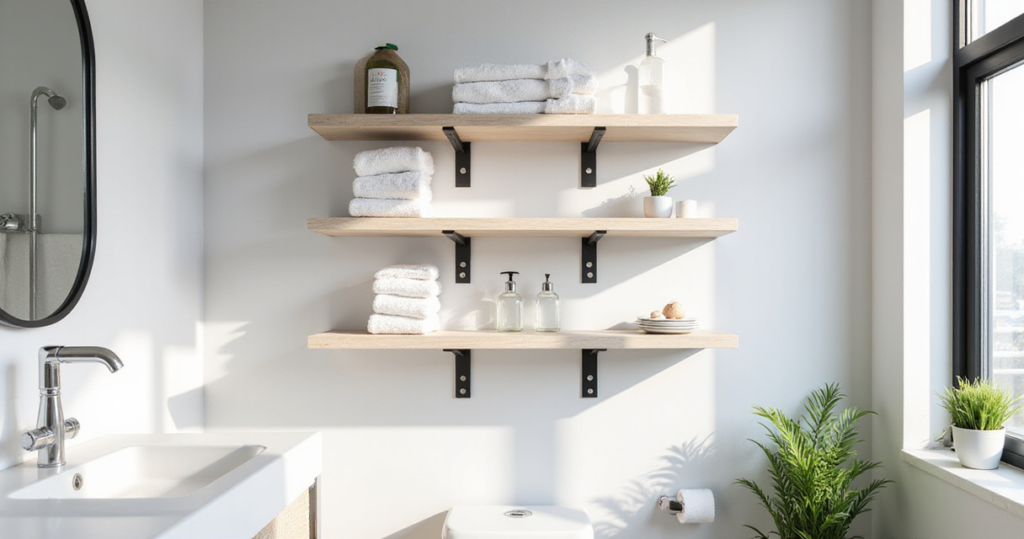Small bathrooms present a universal design puzzle that transcends cultures and continents. Whether in a Tokyo apartment or a New York brownstone, the challenge remains the same: creating functionality within limited square footage without sacrificing style or comfort. As someone who has navigated the intricate balance of Eastern minimalism and Western practicality in my own designs, I’ve discovered that small bathroom decor isn’t just about clever storage—it’s about creating a harmonious space that feels expansive despite its dimensions.
The most successful small bathroom transformations embrace both practical solutions and thoughtful aesthetic choices that speak to your personal design language. When every inch matters, each decision becomes an opportunity to blend form and function in ways that reflect your unique cultural perspective and lifestyle needs. Let’s explore how to transform your compact bathroom into a sanctuary that feels surprisingly spacious, organized, and beautiful.
1. Embrace Vertical Storage with Wall-Mounted Shelves
In small bathroom decor, the vertical plane offers untapped potential that floor space simply cannot match. Traditional cabinets quickly consume precious floor area, making movement feel restricted and the room claustrophobic. Wall-mounted shelving changes this dynamic entirely by utilizing the vertical dimension, creating storage where none existed before while keeping the floor clear and visually open.
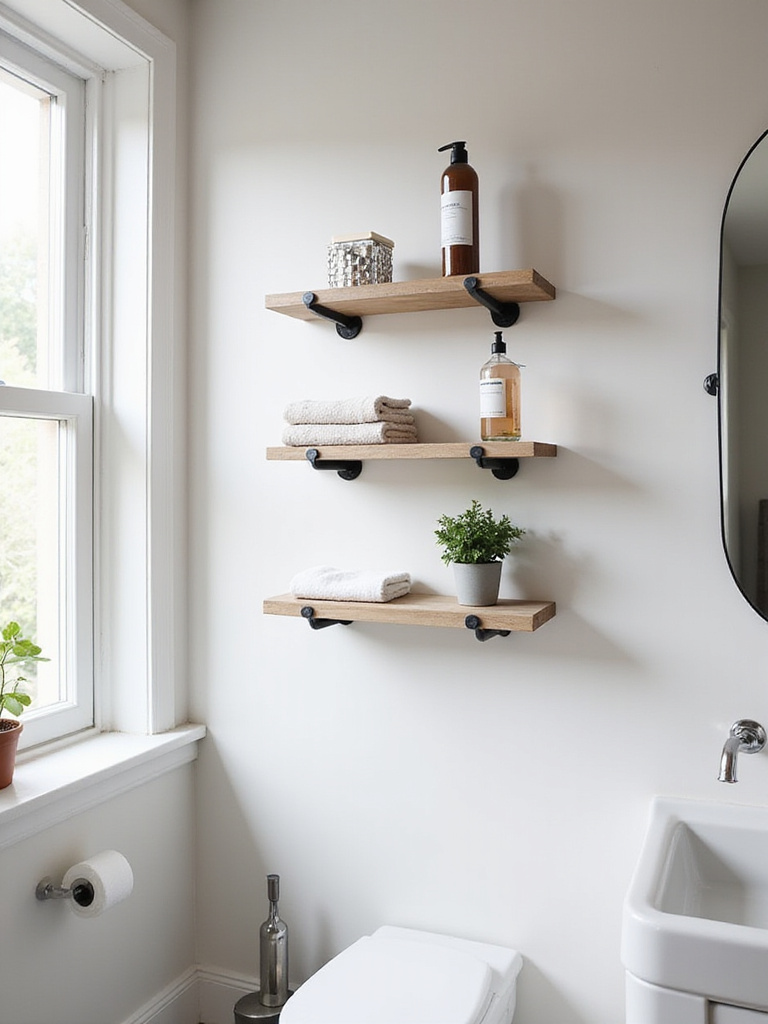
The beauty of vertical shelving lies in its versatility across design traditions. Whether you prefer the clean lines of Scandinavian simplicity or the warm, layered approach of Mediterranean style, wall-mounted shelves can be adapted accordingly. Materials matter significantly in the humid bathroom environment—opt for treated wood, metal (particularly stainless steel), glass, or moisture-resistant laminates that can withstand daily exposure to humidity while complementing your aesthetic direction.
The designer’s secret here is to create visual rhythm with your shelving by varying shelf lengths and depths on a single wall. This dynamic approach not only maximizes storage but draws the eye upward, visually expanding your bathroom’s perceived height while creating an artistic installation that serves a practical purpose.
2. Install a Large Mirror to Double Your Space Visually
The inspiration for this collection struck when I visited a tiny traditional Japanese bath house that felt surprisingly spacious despite its modest dimensions. The secret? A strategically placed mirror that effectively doubled the visual space. Mirrors in small bathroom decor perform a kind of spatial magic—they reflect not just your image but the entire room, creating an optical illusion that pushes walls outward and makes the ceiling appear higher.
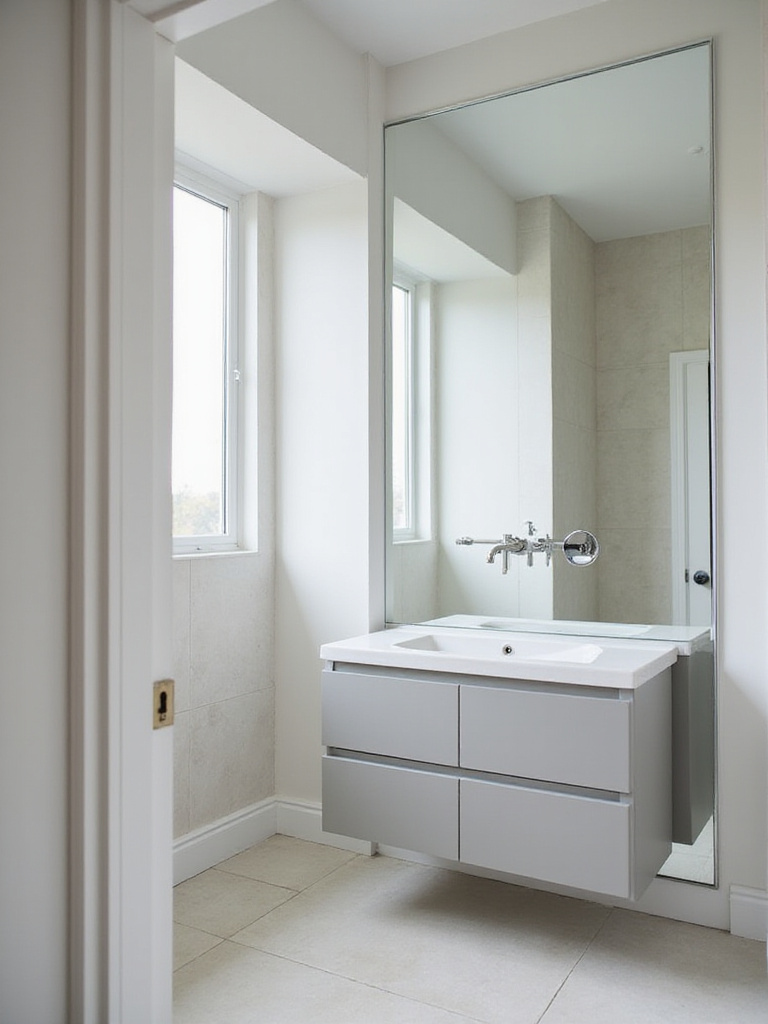
For maximum impact, consider installing a mirror that spans nearly the entire width of a wall, particularly above the vanity. Placement matters tremendously; positioning your mirror to reflect a window or light source multiplies brightness throughout the space. In cultures where light holds spiritual significance, this reflection takes on deeper meaning—it’s not just about aesthetics but about amplifying positive energy throughout the space.
“A mirror doesn’t just reflect an image; it reflects light, space, and possibility. In small spaces, this reflection becomes a form of spatial poetry.” — Traditional Japanese design principle
The craftsmanship in this collection tells a story of how mirrors have been used across cultures to create the illusion of expanded space. As we move from reflection to color, we’ll see how the palette you choose can further enhance this sense of openness.
3. Choose Light and Bright Wall Colors
After months of sourcing and curation, I’ve observed that color choice creates perhaps the most immediate impact on how spacious a bathroom feels. Dark colors, while dramatic and sometimes culturally significant, absorb light and make walls feel as though they’re closing in. Light colors do precisely the opposite—they reflect light throughout the room, creating an airy, expansive atmosphere where walls seem to recede rather than encroach.
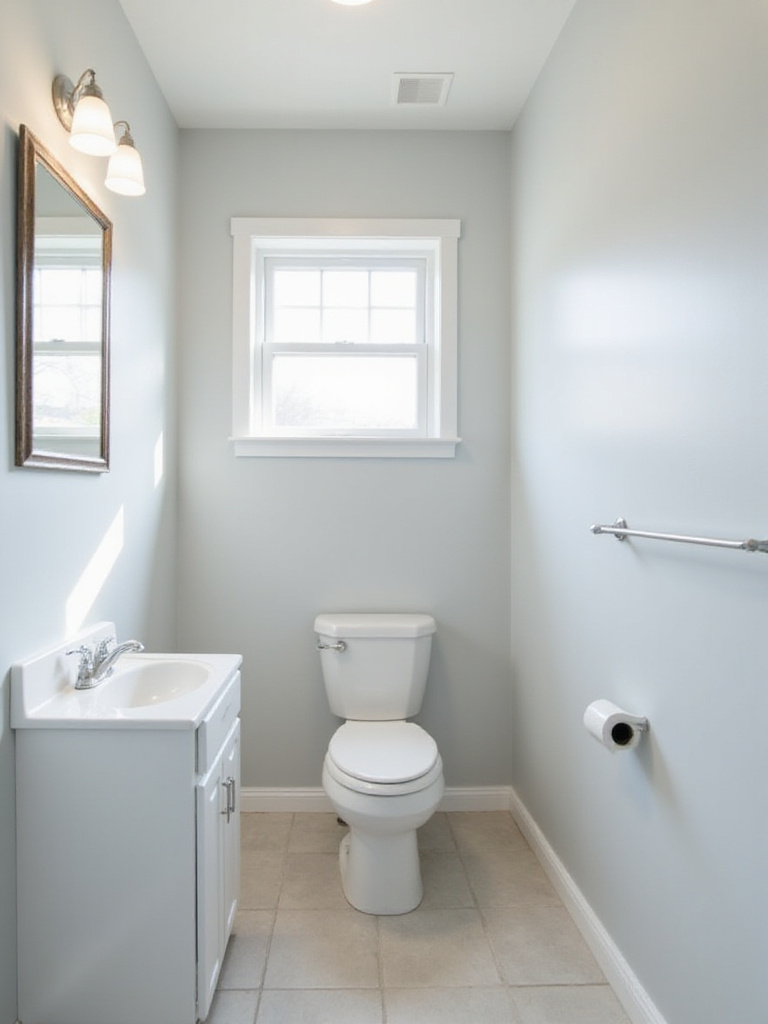
This principle transcends cultural preferences, though the specific light tones you select might be influenced by your heritage or design inspiration. Crisp whites create a clean, gallery-like backdrop in the Scandinavian tradition. Soft, warm whites might evoke Mediterranean warmth. Pale blues can reference water elements important in many Eastern design philosophies, while light greens might connect to nature in a subtle, calming way that makes the bathroom feel like a peaceful garden retreat.
- Popular light color choices:
- Pure white (maximizes light reflection)
- Soft off-whites (adds warmth while maintaining brightness)
- Pale gray (modern neutrality with depth)
- Light blue (creates a spa-like atmosphere)
- Sage green (brings nature indoors subtly)
The magic of this piece lies in how these light colors serve as a canvas for more personal expressions of cultural identity through accessories and accents. Now, let’s illuminate this canvas further with strategic lighting choices.
4. Maximize Light with Smart Fixtures
The unexpected pairing that always works in small bathroom decor is layered lighting with light wall colors. A single ceiling fixture creates harsh shadows and dark corners that make the space feel smaller and less inviting. Instead, approaching lighting as a composition of different sources—ambient, task, and accent—eliminates shadows and distributes light evenly throughout the space, making it feel larger, brighter, and more dynamic.
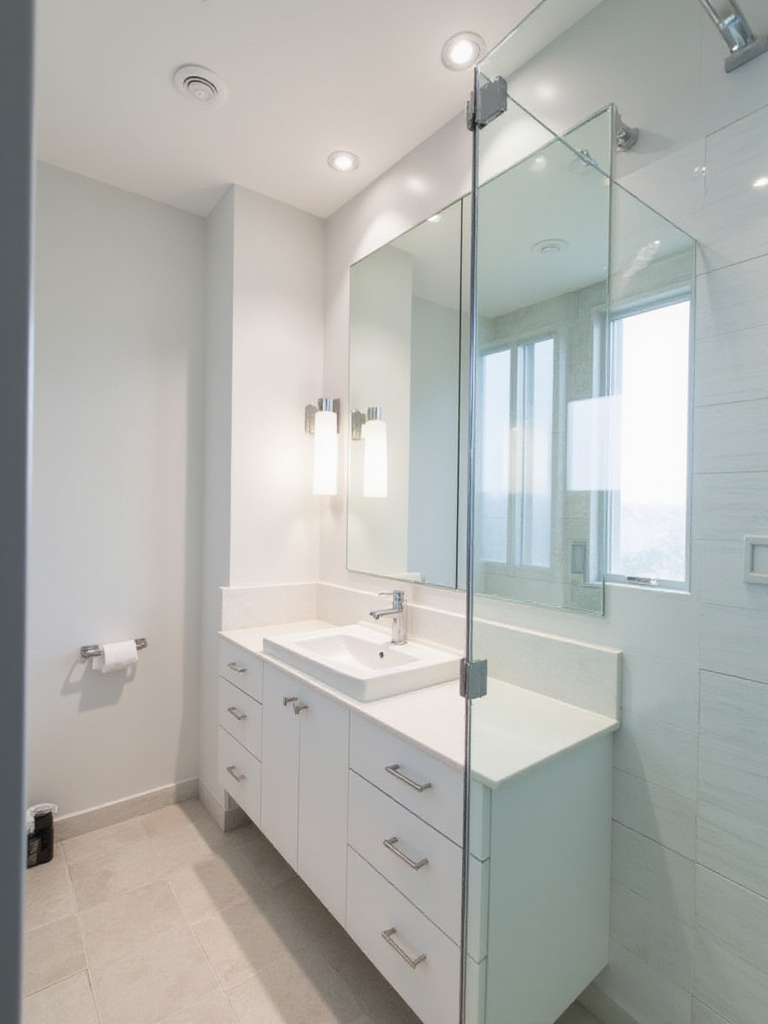
This layered approach to lighting has roots in both Eastern and Western design traditions. In Japanese interiors, light is often diffused and layered to create a sense of depth and tranquility. In Western design, strategic task lighting ensures functionality while ambient lighting sets the mood. For small bathrooms, this means combining recessed ceiling lights for general illumination with properly positioned vanity lights (ideally sconces at eye level on either side of the mirror) for shadow-free grooming.
Beyond aesthetics, the ecological impact matters because energy-efficient LED fixtures not only save electricity but generate less heat—an important consideration in a small bathroom where temperature control can be challenging. The interplay between natural and artificial light creates a bathroom that feels spacious throughout the day and into evening hours.
5. Opt for a Floating Vanity for Floor Space
While designed for the living room, we’ve seen creative uses of floating furniture in bathrooms across cultures. A floating vanity—mounted directly to the wall with no legs or base—creates a continuous visual line from wall to wall across the floor. This uninterrupted flow makes the bathroom feel significantly more open and spacious compared to traditional floor-standing vanities that visually and physically block space.
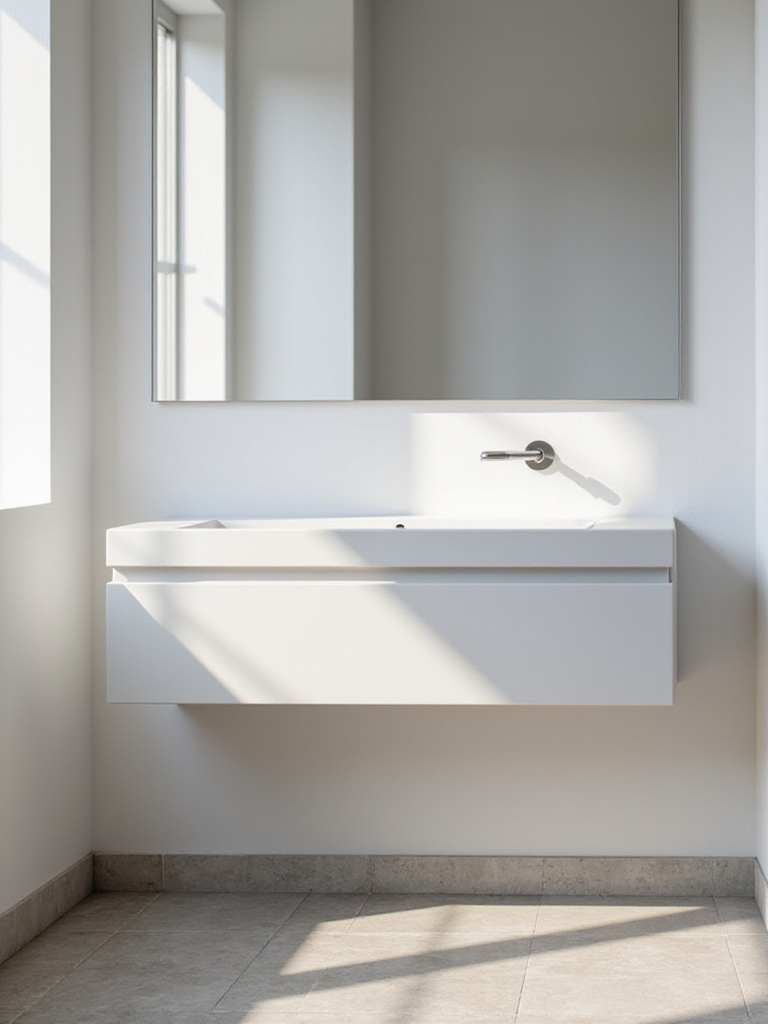
The concept of “floating” elements has particular resonance in East Asian design traditions, where visual lightness creates spiritual lightness. A wall-mounted vanity embodies this philosophy perfectly, lifting functional elements off the ground to create breathing room below. This approach not only makes cleaning easier but also allows the flooring material to extend fully to the wall, creating a more cohesive, expansive feeling.
- Benefits of floating vanities:
- Creates usable floor space beneath
- Makes the bathroom appear larger
- Simplifies cleaning
- Provides design flexibility
- Works with various aesthetic styles
The versatility reveals itself when you pair this floating element with complementary design choices. For those with even tighter spaces, we can take space-saving a step further by reconsidering the sink’s placement altogether.
6. Consider a Corner Sink to Save Room
The environmental story behind this piece began with observing how traditional homes across cultures utilize corners efficiently. In small bathroom decor, corners often become dead space—awkward areas that serve no purpose. Installing a corner sink transforms this overlooked area into a functional focal point while freeing up valuable wall space for other fixtures or storage.
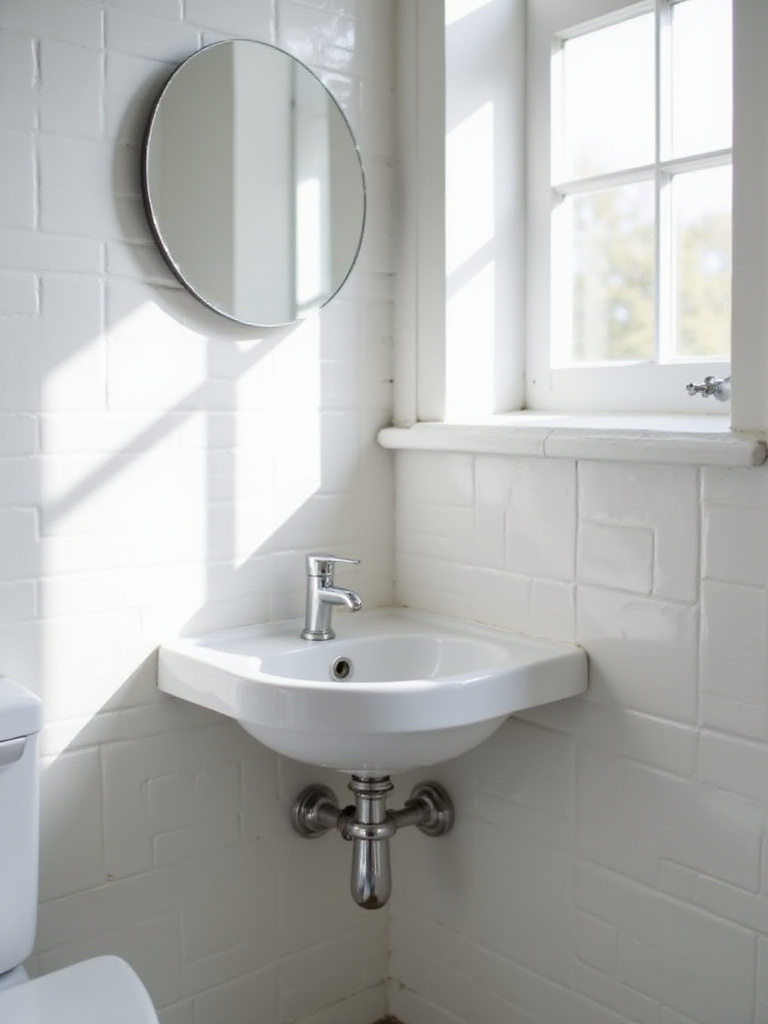
Corner sinks come in various configurations to suit different design aesthetics. A wall-mounted corner sink with clean lines might complement a minimalist Japanese-inspired bathroom. A pedestal corner sink with more ornate details could enhance a space with European influences. The key is selecting a size that fits the corner properly without overwhelming the space or impeding movement around other fixtures.
The sustainable journey of this material involves recognizing that smart design reduces waste—not just in materials but in space itself. By utilizing corners effectively, you’re practicing a form of spatial sustainability that makes your small bathroom more functional without requiring additional square footage.
7. Utilize Over-the-Toilet Storage Solutions
Looking closely and you’ll notice the subtle texture of opportunity in the space above your toilet—an often overlooked vertical zone that offers significant storage potential. In small bathroom decor, this area represents prime real estate that can be utilized without consuming any additional floor space, making it an essential consideration for maximizing functionality.
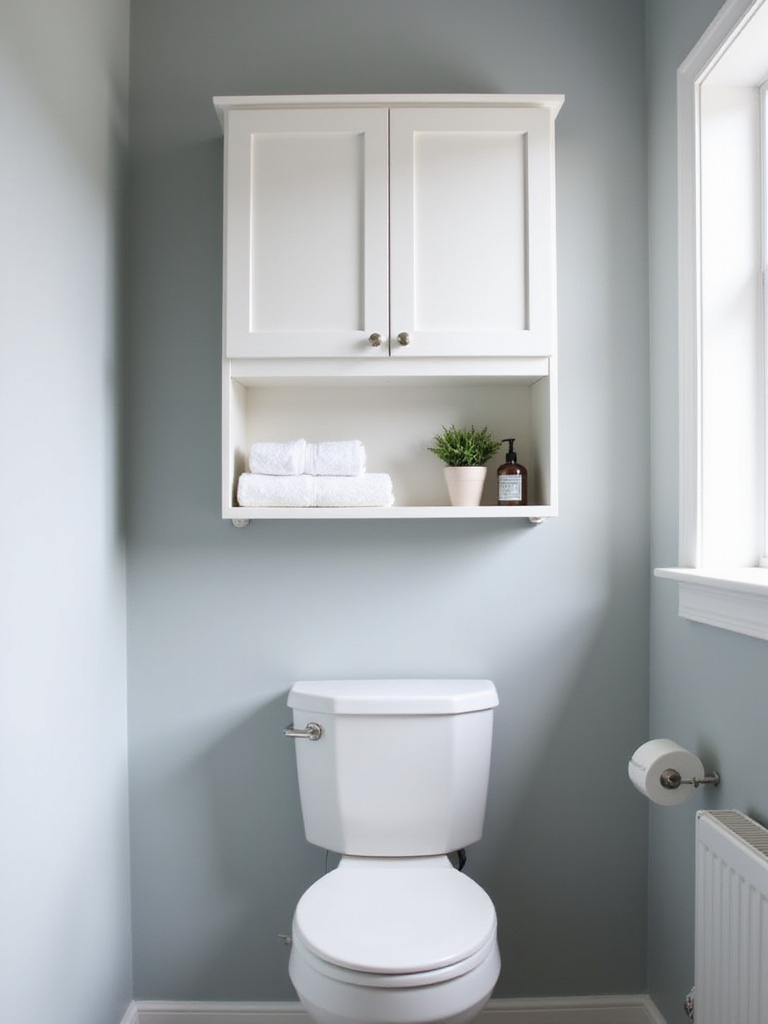
This approach to utilizing space above fixtures has historical precedent in many cultures where living quarters were tight. From traditional Japanese tansu cabinets designed to fit specific spaces to European built-ins that maximize every nook, the principle remains the same: look up to find space. Modern over-the-toilet storage options range from freestanding units that frame the toilet to wall-mounted cabinets or simple floating shelves installed directly onto the wall.
What makes this design special is the way it transforms what would otherwise be empty wall space into a functional storage zone, perfect for extra toilet paper, folded towels, or decorative elements that personalize your bathroom. As we continue our journey through the small bathroom, let’s look at another often-neglected vertical surface.
8. Add Hooks or Organizers to the Back of the Door
Many homeowners wonder how to maximize every square inch in a small bathroom, often overlooking one of the most accessible vertical surfaces: the back of the door. This hidden canvas offers remarkable potential for adding quick, accessible storage without taking up any floor or wall space within the main bathroom area. It’s a simple yet effective strategy that works across design traditions from minimalist to maximalist.
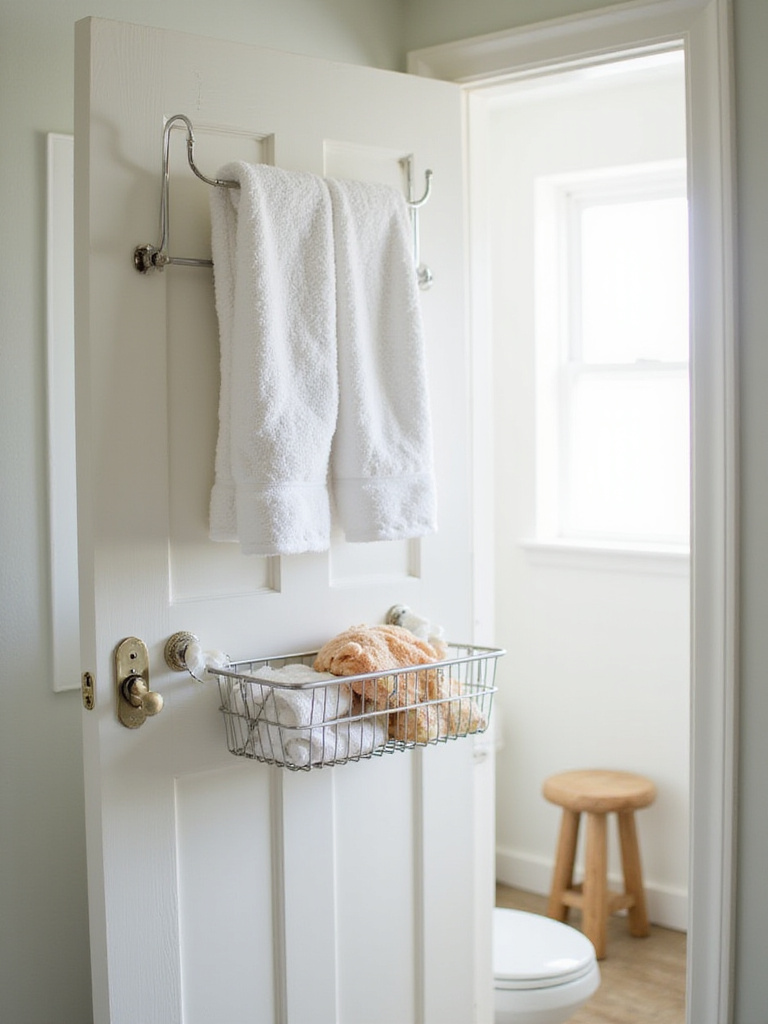
The beauty of door-back storage lies in its adaptability to your specific needs and aesthetic preferences. Simple adhesive hooks work well for lightweight items like hand towels or loofahs. Sturdier over-the-door racks can hold bath towels and robes. Hanging caddies or pockets can organize hair tools, toiletries, or cleaning supplies. The key is choosing organizers that complement your overall design approach while providing practical storage that keeps items off counters and floors.
The artisan collective that creates these pieces understands that functionality doesn’t have to sacrifice beauty. Choose hooks or organizers that reflect your personal style—whether sleek and modern or warm and traditional—to ensure they contribute positively to your small bathroom decor while solving storage challenges.
9. Find Clever Under-Sink Storage Solutions
The challenge of awkward spaces becomes easier when you approach the area under your sink as a puzzle to be solved rather than a limitation to be accepted. The plumbing pipes create irregular spaces that standard storage solutions can’t efficiently utilize, but with creative thinking, this awkward zone can become a storage powerhouse in your small bathroom decor strategy.
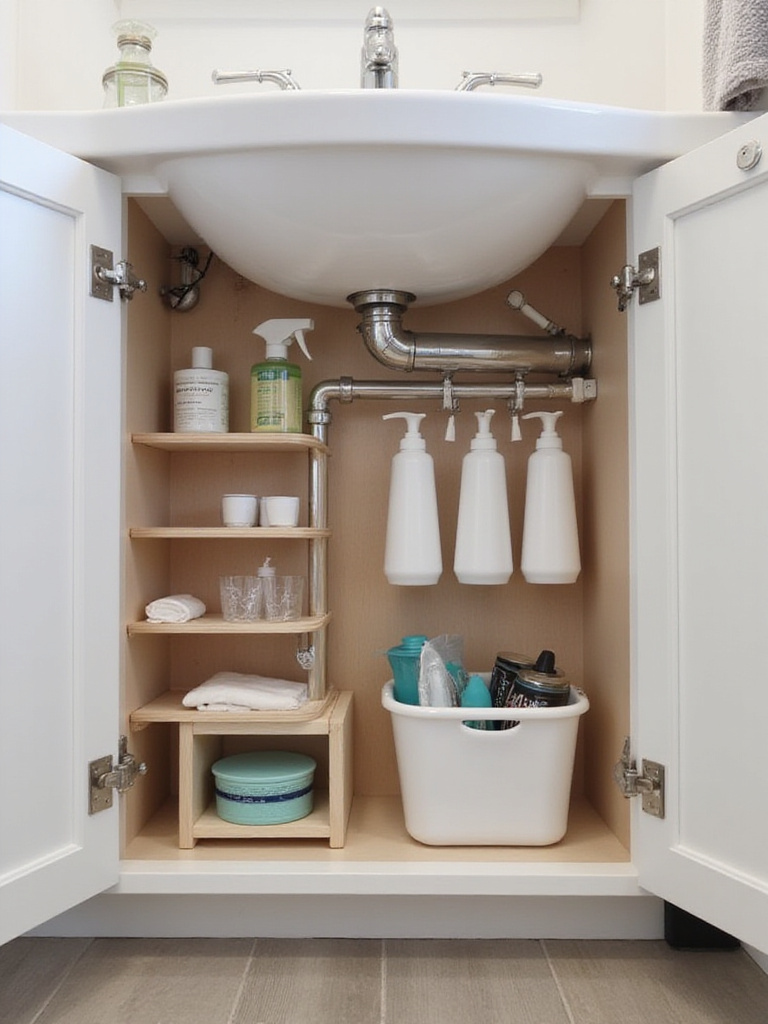
This approach to problem-solving has parallels in many cultural design traditions. In traditional Japanese carpentry, for instance, irregularly shaped spaces are often addressed with custom solutions that work with, rather than against, structural elements. For your under-sink area, look for adjustable shelving systems with cutouts for pipes, pull-out drawers specifically designed to navigate around plumbing, or collections of smaller bins and baskets that can be arranged to fit the available space.
- Effective under-sink organizers:
- Expandable shelves with pipe cutouts
- Stackable drawers with adjustable heights
- Pull-out systems on slides
- Collections of varied-size bins
- Tension rods for hanging spray bottles
What surprises clients most is how this works with even the most challenging under-sink configurations. With the lower cabinet organized, let’s move up to the countertop and address another common source of bathroom clutter.
10. Mount Dispensers for Soap and Lotion
The revival of this classic form comes with a twist in modern small bathroom decor. Wall-mounted dispensers have evolved from utilitarian public bathroom fixtures to stylish accessories that free up precious counter space while adding a touch of spa-like convenience to your bathroom. By lifting soap, lotion, and other liquids off horizontal surfaces, you immediately create a cleaner, more streamlined look.
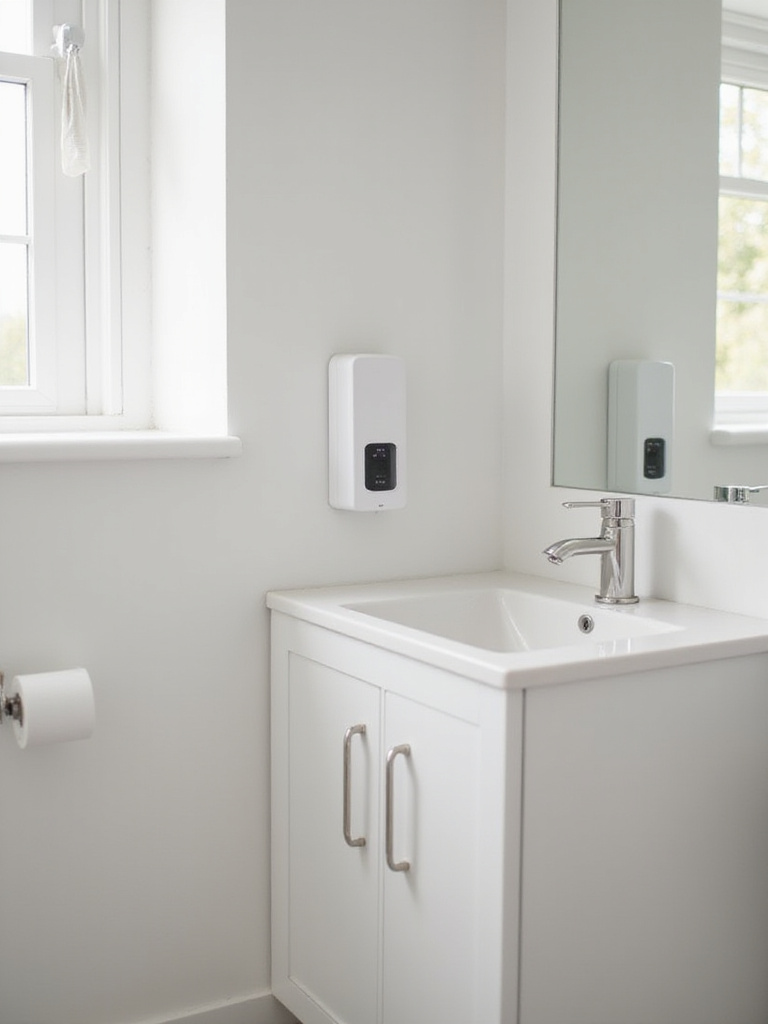
These dispensers connect to both Eastern and Western design sensibilities. The minimalist approach of removing bottles from sight appeals to Japanese-inspired design, while the hotel-like luxury of matching dispensers speaks to Western spa aesthetics. Available in various finishes from brushed nickel to matte black, these fixtures can be selected to complement your existing hardware while providing a cohesive look.
For those worried about maintenance, modern dispensers are designed for easy refilling and cleaning, making them practical for daily use. The composition comes together when you coordinate finisher across all your bathroom fixtures, creating a harmonious look that feels intentionally designed rather than pieced together.
11. Use a Slim Rolling Cart for Essentials
If you’ve struggled with similar rooms before, you’ll appreciate the flexibility that a slim rolling cart brings to small bathroom decor. These narrow, mobile storage solutions slide perfectly into tight spaces that would otherwise go unused—like the gap between a vanity and toilet, or beside the shower. Their slender profile maximizes storage without impeding movement in tight quarters.
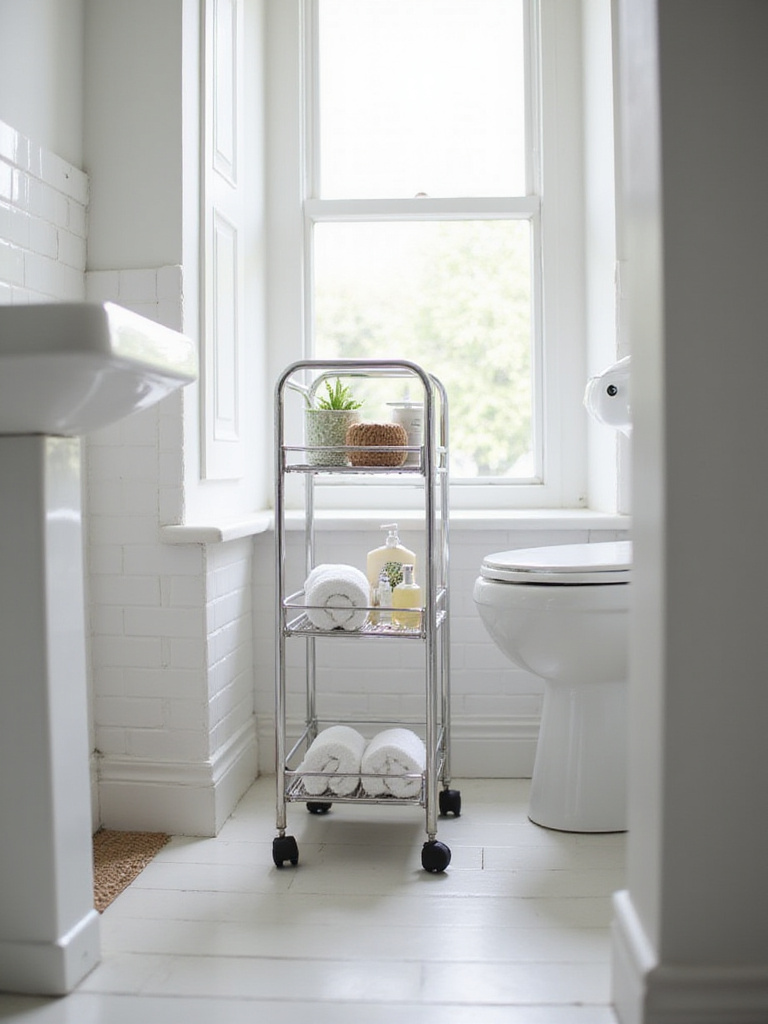
The concept of mobile storage has interesting cultural variations. In many Asian homes where space is at a premium, furniture that can be moved or repurposed is highly valued. Western design has embraced this flexibility more recently, recognizing that adaptable pieces create more functional spaces. A rolling cart in your bathroom embodies this cross-cultural wisdom, providing accessible storage that can be moved as needed.
- Best uses for bathroom rolling carts:
- Extra toilet paper and toiletries
- Hair styling tools and products
- Cleaning supplies
- Guest amenities
- Small plants or decorative elements
The traditional methods used result in a piece that’s both functional and attractive. As we continue organizing our small bathroom, let’s address another essential element: towels.
12. Install Multiple Towel Bars or Rings
When clients ask us about balancing style with comfort in small bathroom decor, towel storage invariably enters the conversation. Wet towels draped over shower doors or piled on limited counter space create instant visual clutter and prevent proper drying. Installing multiple towel bars, rings, or hooks utilizes vertical wall space efficiently while keeping towels neatly organized and properly aired.
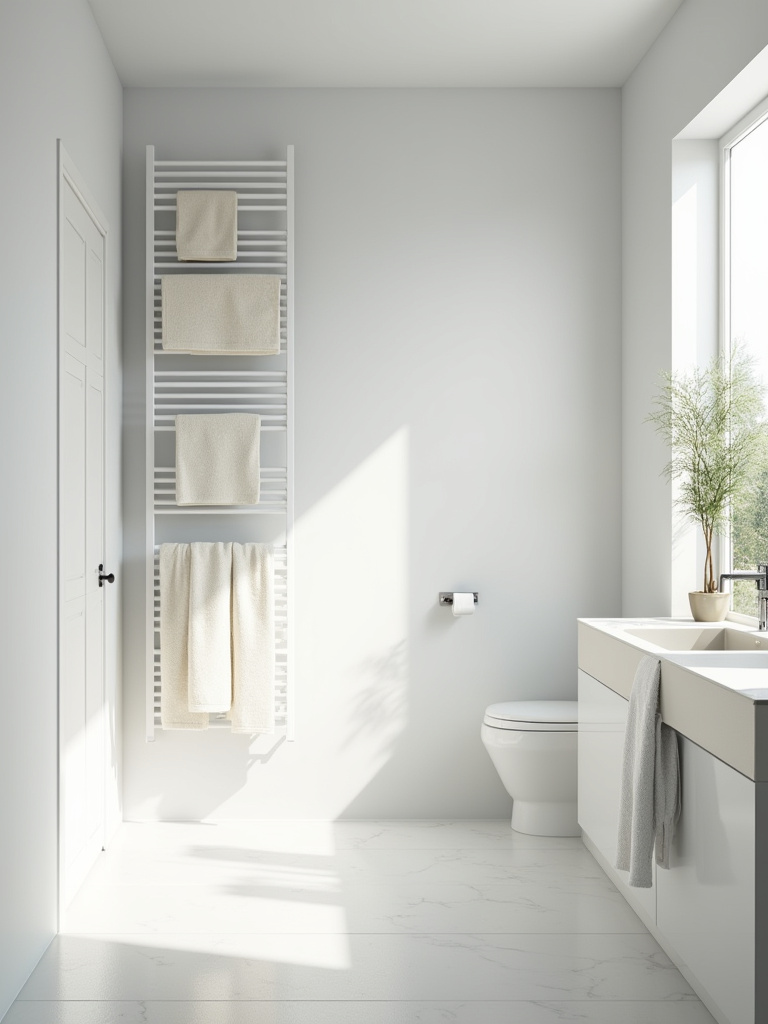
This approach to towel storage draws from both practical necessity and aesthetic consideration across cultures. In Scandinavian design, functional elements are often displayed rather than hidden, but in a thoughtful, organized manner. Japanese bath culture emphasizes proper drying and storage of bath linens. By installing multiple towel bars—perhaps stacked vertically on a narrow wall section, or strategically placed on the back of the door—you create dedicated spots for each towel while maintaining visual order.
Running your hand across this material reveals the importance of selecting appropriate hardware that complements your overall design scheme. Coordinating finishes across towel bars, hooks, and other fixtures creates a cohesive look that feels intentional and designed rather than pieced together as an afterthought.
13. Create Built-in Shower Niches
The artisans behind these designs began with a simple observation: shower caddies that hang from the showerhead or balance on tub edges create visual clutter and never quite stay in place. Built-in shower niches offer an elegant solution by recessing storage directly into the shower wall, creating a streamlined look that keeps toiletries organized without consuming any of the precious showering space in small bathroom decor.
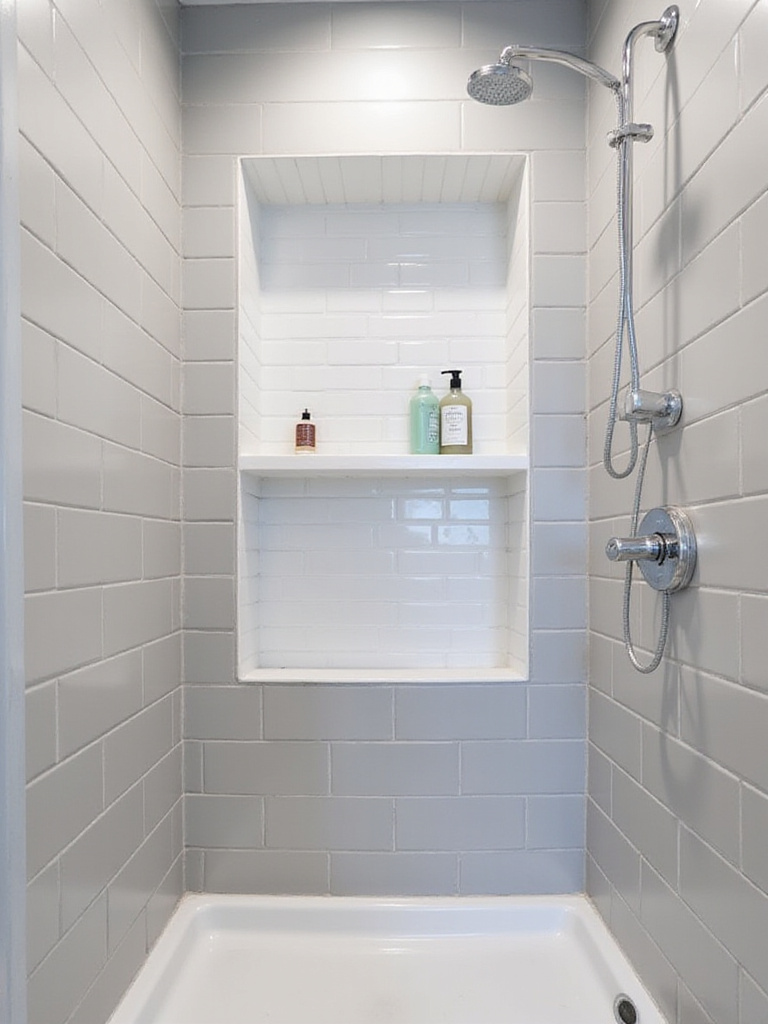
These recessed shelves have historical precedent in hammams and bathhouses across cultures, where niches were built into stone walls to hold oils and cleansing materials. Modern shower niches continue this tradition while addressing contemporary needs. They can be designed in various sizes and configurations—a single large niche or multiple smaller ones, positioned at convenient heights for different users or products.
The maker’s journey from apprentice to master influenced the development of these shower niches, which require skilled waterproofing to prevent moisture problems. While they’re easiest to incorporate during initial construction or major renovation, pre-formed shower niches are now available that can be installed during less extensive remodels, making this luxury feature more accessible for small bathroom updates.
14. Select a Clear or Lightly Patterned Shower Curtain
Unlike conventional options, this approach reduces visual barriers in your small bathroom decor. A heavy, opaque shower curtain effectively divides your bathroom into separate zones, making the overall space feel smaller and more confined. Choosing a clear or lightly patterned shower curtain maintains visual continuity throughout the room, allowing light to pass through and the eye to travel uninterrupted across the entire space.
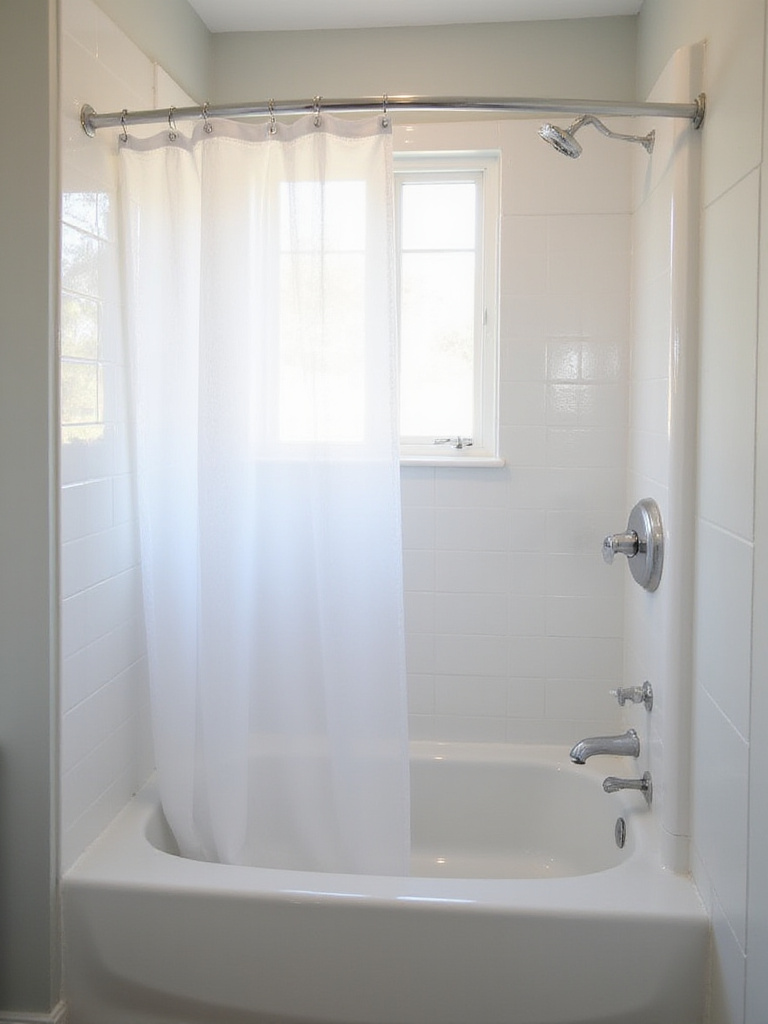
This concept of visual flow has parallels in traditional Japanese architecture, where shoji screens filter light while maintaining a sense of openness between spaces. In Western design, the principle manifests in the use of glass and transparent elements to create a sense of expanded space. A clear vinyl curtain offers maximum transparency, while a lightly patterned or textured option provides some visual interest and privacy while still allowing light transmission.
The cultural heritage preserved in each piece includes understanding how visual barriers affect spatial perception. By choosing transparency or subtle pattern over heavy opacity, you maintain the integrity of your bathroom’s full dimensions, making it feel more expansive and connected.
15. Use Bold Floor Tile to Create Interest
The unexpected environmental benefit comes from directing attention downward in small bathroom decor. While conventional wisdom suggests keeping everything light and neutral in small spaces, a bold floor pattern creates a strategic focal point that adds personality without overwhelming the room. This approach draws the eye to the floor, creating visual interest that distracts from the room’s compact dimensions.
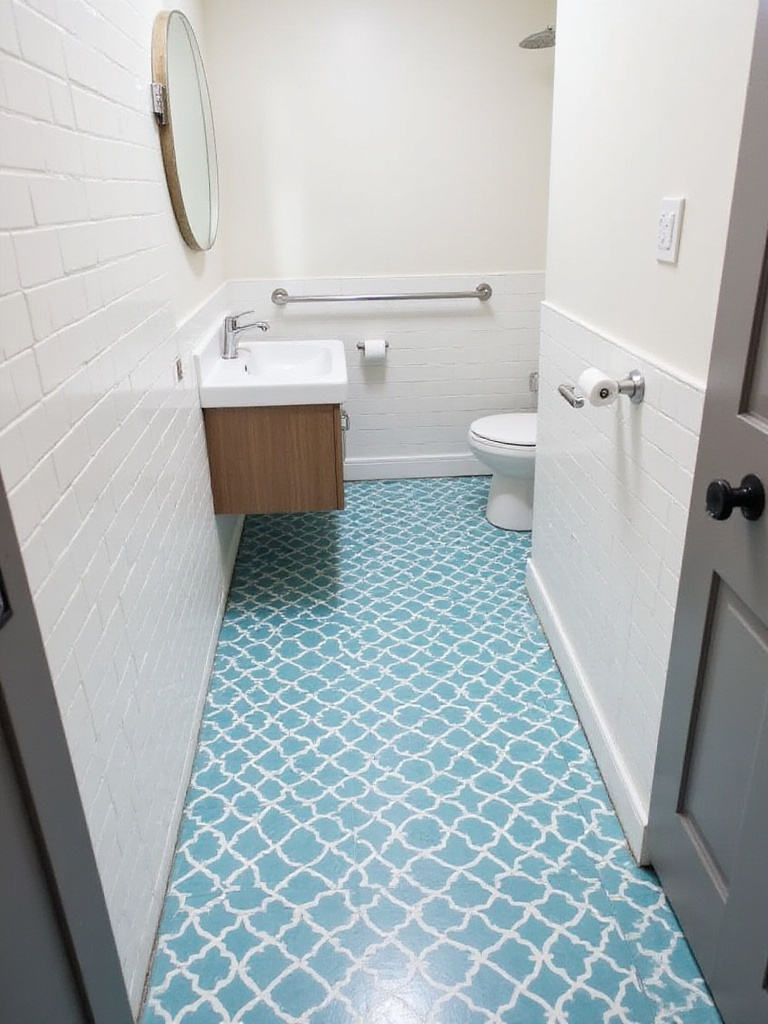
This design strategy has cultural precedents worldwide. Moroccan zellige tiles, Portuguese azulejos, Mexican talavera—all these traditions embrace bold patterns underfoot while maintaining simpler walls. The key to success is balance; if your floor makes a statement, keep the rest of the bathroom relatively subdued to avoid visual chaos. The floor becomes the room’s defining feature, adding character while the simpler walls recede, making the space feel larger.
The finishing touch that elevates the entire look comes from choosing the right pattern scale for your space. In very small bathrooms, medium-sized patterns often work better than tiny ones (which can look busy) or extremely large ones (which may show too few pattern repeats). This approach to small bathroom decor creates a foundation of interest while maintaining visual spaciousness above.
16. Keep Decor Minimal and Uncluttered
The silhouette draws inspiration from both Eastern and Western minimalist traditions in small bathroom decor. In Japanese design philosophy, the concept of “ma” celebrates the beauty of negative space—the breathing room between objects that allows each piece to be fully appreciated. Western minimalism similarly values intentional simplicity and the removal of excess. Both approaches recognize that in small spaces, less truly becomes more.

This doesn’t mean your bathroom should feel sterile or impersonal. Rather, it suggests that each decorative element should be chosen with purpose and placed with intention. A single beautiful plant, an artful soap dish, or a carefully selected piece of wall art can make more impact than multiple smaller accessories competing for attention. Focus on quality over quantity, selecting items that bring genuine joy or serve a specific function.
For those hesitant about bold patterns, minimalism offers a different path to visual interest through texture and quality materials rather than numerous objects. The styling mistake most people make is trying to incorporate too many ideas or items into a small space, creating visual noise that makes the room feel chaotic and smaller than it actually is.
17. Choose Small-Scale Accessories
The evolution of this trend reflects broader cultural shifts toward mindful consumption and appreciation of quality over quantity. In small bathroom decor, the scale of accessories matters tremendously. Oversized soap dispensers, bulky tissue box covers, or large decorative objects quickly overwhelm limited counter space and make the room feel disproportionate and cramped. Choosing smaller, more delicate accessories maintains visual harmony while still allowing for personal expression.
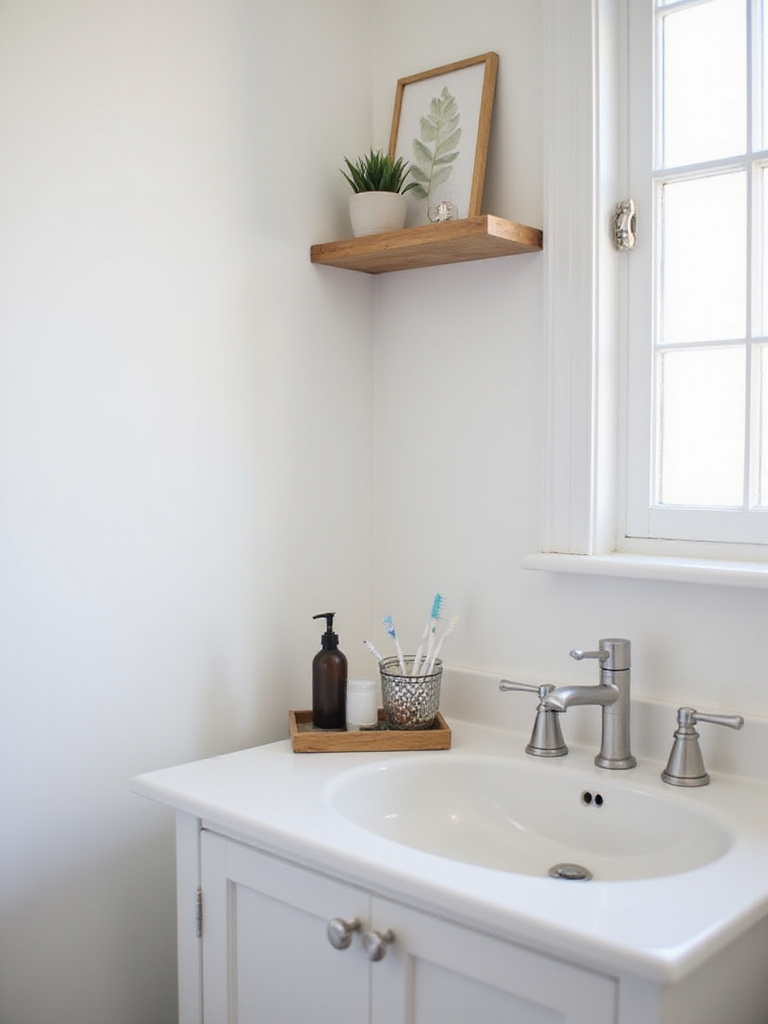
This principle of appropriate scaling has deep roots in design traditions worldwide. In Japanese aesthetics, the concept of proportion and balance is paramount. European design similarly emphasizes the relationship between object size and spatial context. By selecting slender dispensers, petite plants, or slim trays, you add necessary functionality and personality without dominating the limited surface area available in a small bathroom.
- Small-scale accessories to consider:
- Narrow soap dispensers
- Petite air plants or succulents
- Slim trays for corralling small items
- Small art prints in thin frames
- Delicate candles or diffusers
The cultural significance preserved in each piece includes understanding that in compact spaces, delicacy often trumps boldness in accessorizing. With the right scale established, we can now introduce elements that bring life and vitality to the space.
18. Introduce Greenery with Small Plants
The forecast for next season already hints at the continued importance of biophilic design—connecting interior spaces with nature—in small bathroom decor. Plants add a refreshing touch of life, color, and organic texture to bathrooms, creating a sense of vitality in what might otherwise feel like a sterile, utilitarian space. The humid environment naturally present in bathrooms actually makes them ideal homes for many plant species, creating a mutually beneficial relationship.
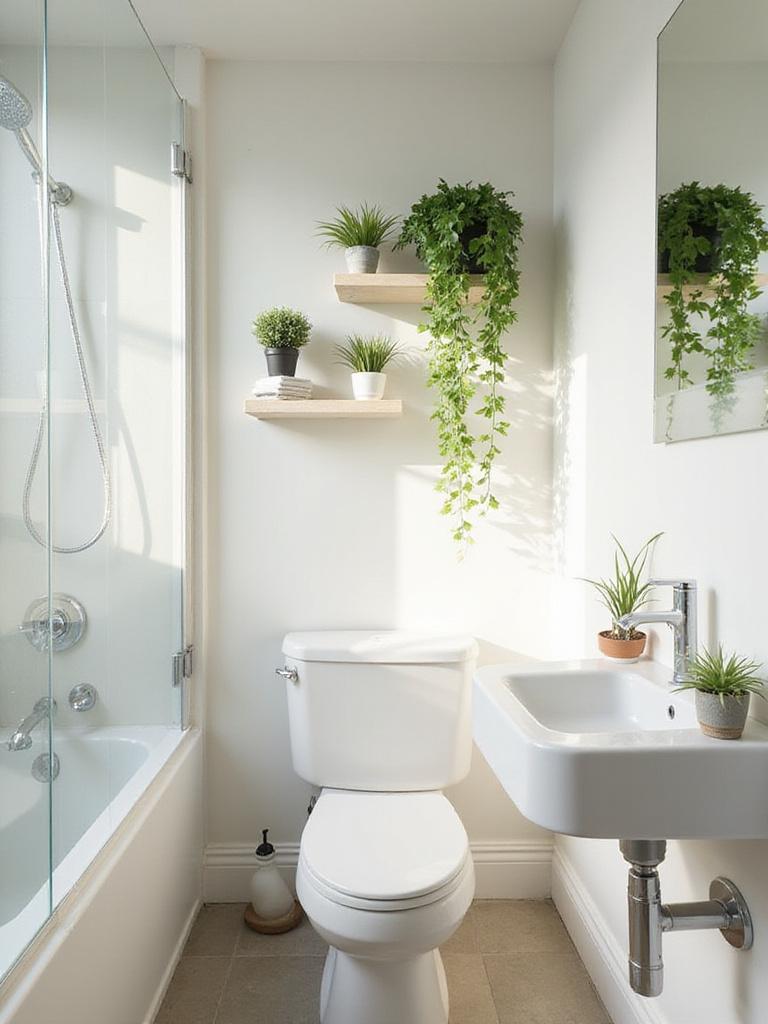
This connection between bathing spaces and plant life has cultural precedents worldwide. Traditional hammams often incorporated small gardens or potted plants to enhance the sensory experience. East Asian bathing traditions similarly value the connection between water, cleansing, and natural elements. Today, incorporating small plants in your bathroom continues this cross-cultural appreciation for how nature enhances wellbeing in intimate spaces.
The styling secret here is to choose plants that thrive in bathroom conditions—humidity-loving varieties like ferns, pothos, or air plants—and place them strategically to maximize their visual impact without cluttering surfaces. A single trailing plant on a high shelf, a small fern beside the sink, or an arrangement of air plants on the window sill can transform the atmosphere of your small bathroom with minimal space commitment.
19. Ensure Good Ventilation and Airflow
The material sourcing makes all the difference in how your small bathroom decor will withstand daily use, but even the finest materials will suffer without proper ventilation. Bathrooms naturally generate significant moisture, and in small spaces, this humidity becomes concentrated. Without adequate airflow, condensation can lead to peeling paint, warped wood, mildew on grout, and even structural damage over time. Beyond preserving your design investments, good ventilation creates a healthier, more comfortable environment.
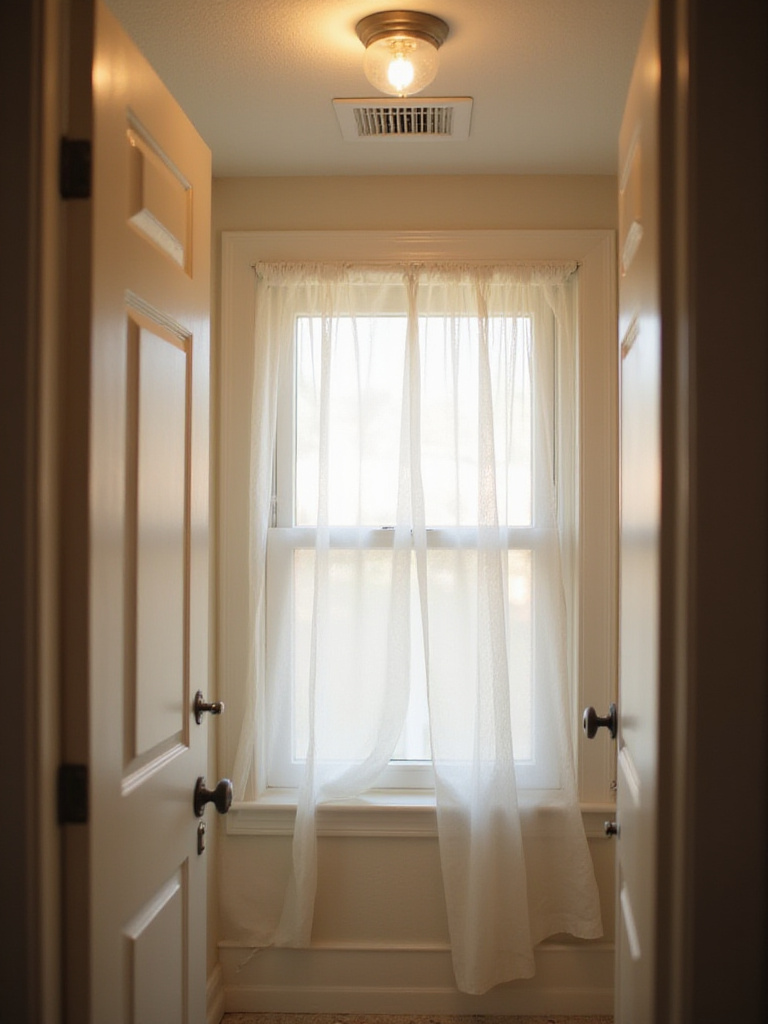
This principle of air circulation has been valued across cultures for centuries. Traditional Japanese bathhouses incorporated clever ventilation systems, while Mediterranean designs often featured windows placed to create cross-breezes. Modern small bathrooms can achieve similar benefits through properly sized exhaust fans vented directly outside, supplemented where possible with natural ventilation from windows or doors left open when the bathroom isn’t in use.
The unexpected benefit of proper ventilation extends beyond preservation—it also allows you to incorporate more luxurious textiles and natural materials in your small bathroom decor, knowing they’ll be protected from excessive moisture that could otherwise cause damage or deterioration.
20. Install a Wall-Mounted Faucet
The third-generation workshop where this comes to life understands that in small bathroom decor, even minor fixtures can have major impact. Wall-mounted faucets exemplify this principle perfectly. By moving the faucet off the countertop and onto the wall behind the sink, you free up valuable horizontal surface area while creating a distinctive design feature that draws from both contemporary and historical precedents.
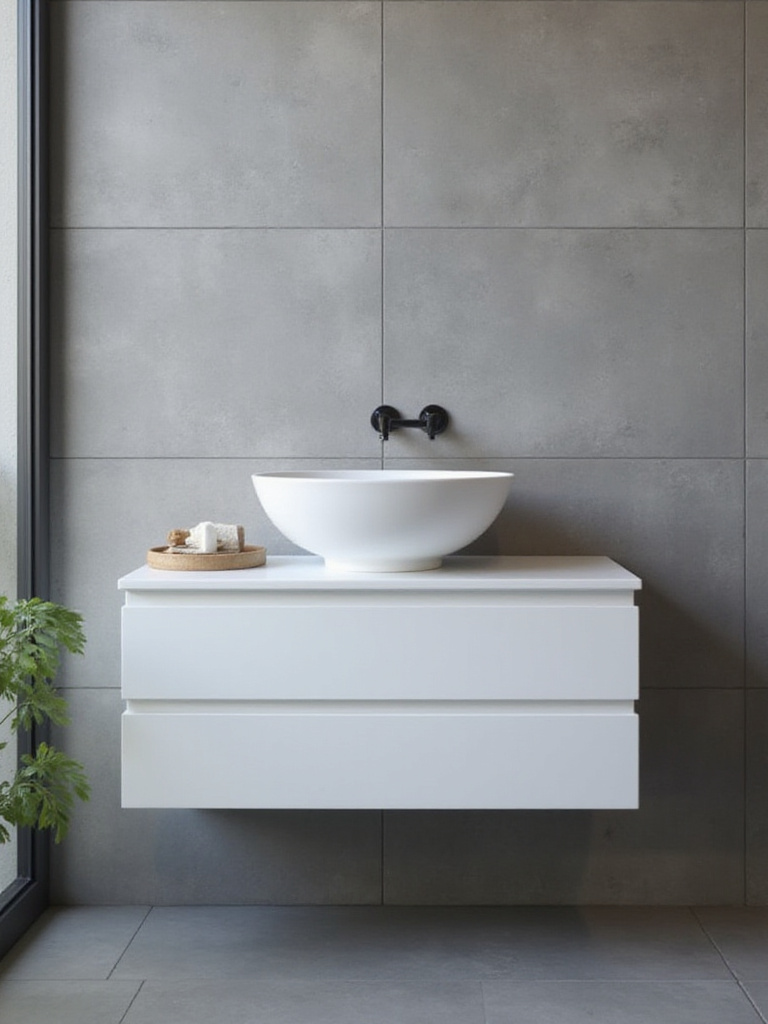
This approach to faucet placement has interesting cultural variations. In many European designs, wall-mounted fixtures have long been popular for their clean, architectural appearance. Contemporary Asian-influenced bathrooms often embrace this style for its minimalist efficiency. The practical benefit in any small bathroom is significant: the entire sink deck becomes usable space, or can simply remain clear for a less cluttered aesthetic.
- Benefits of wall-mounted faucets:
- Frees up counter space
- Creates a clean, designer look
- Makes sink cleaning easier
- Allows for smaller or uniquely shaped sinks
- Adds unexpected visual interest
The collaboration began with a conversation about how traditional elements can be reimagined for contemporary spaces. While installation requires more extensive plumbing work than a standard faucet replacement, the resulting clean lines and space efficiency make wall-mounted faucets worth considering for small bathroom renovations.
21. Utilize the Space Above the Door Frame
The discovery of this technique happened when analyzing traditional homes in space-conscious cultures, where no potential storage area went unused. The narrow space above the bathroom door frame—typically left bare in most homes—offers surprising potential for additional storage or display space in small bathroom decor. This often-overlooked vertical real estate can be put to work without impeding movement or interfering with the room’s main functions.
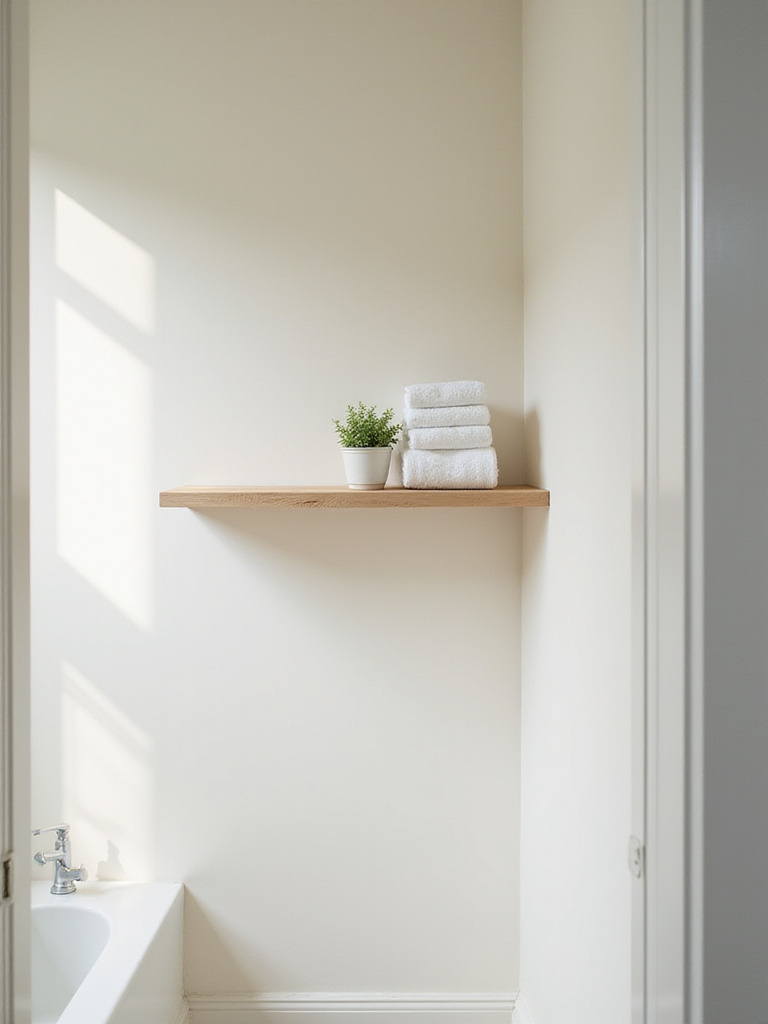
This approach connects to age-old wisdom about utilizing every available inch in compact living quarters. In traditional Japanese homes, the space above doorways might hold small treasures or seasonal items. European cottage design similarly maximizes unusual nooks for storage. In your bathroom, a simple floating shelf installed above the door frame can hold extra toilet paper, folded guest towels, or decorative items that don’t require frequent access.
The design language evolved from traditional patterns that emphasize resourcefulness and spatial efficiency. While accessing this high storage requires a step stool, the trade-off is worthwhile in truly compact bathrooms where every inch of additional storage space matters. This final touch completes our journey through the small bathroom, having explored every possible dimension for maximizing both function and beauty.
Conclusion
The journey through these 21 small bathroom decor ideas reveals a fundamental truth: limitations often spark the most creative solutions. By thoughtfully addressing each dimension of your compact bathroom—from the practical aspects of storage and ventilation to the visual elements of color and scale—you can transform a challenging space into a harmonious sanctuary that feels surprisingly spacious.
What makes these approaches particularly powerful is their cross-cultural resonance. Whether drawing from Eastern philosophies that celebrate negative space and natural elements, or Western traditions that value efficiency and personalization, these ideas transcend specific design styles to address universal human needs for both functionality and beauty in intimate spaces.
Remember that small bathroom decor isn’t about implementing every idea at once, but rather selecting the strategies that best address your specific challenges while reflecting your personal aesthetic. With thoughtful planning and selective implementation, your small bathroom can become not just a functional necessity but a daily retreat that brings genuine pleasure through its perfect balance of form and function.
